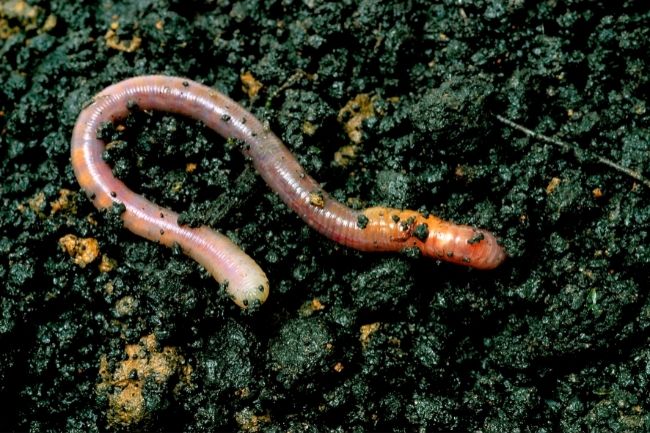Earthworms do not have eyes, in the sense that we think of them. Instead, they have a number of light receptors to help them detect light and dark. These receptors cannot make out forms and colours in the way our eyes can.
Contents
What are eyes?
Eyes come in many different forms across different species. While humans and many mammals have camera-type eyes, many insects have compound eyes, where many lenses work together to create complex images. Insects can also have simple eyes, which are mostly used to detect light.
All these different kinds of eyes help to decipher light in different ways. Some are able to capture complex images, or even sense different kinds of light, such as ultraviolet. Others only sense how bright the light is, or make out rough shapes.
Even pupil-type can be significant, with smaller predatory often having vertical pupils, while horizontal pupils often relate to prey species.
All these different eyes help animals to find food, detect predators, find mates and navigate. Depending on how an animal achieves these tasks very different eyes may be required, or indeed no eyes at all.
How do earthworms see?

There are around 4,400 species of earthworms in the world. Earthworms do not have eyes that would be familiar to us, however, they do have what is known as light receptors.
These cannot focus or detect detailed patterns. Instead, they are adapted simply to detect light and dark. These sensors are located within the epidermis, largely within the dorsal section of the worm, meaning the top side. Each sensor is connected together by a number of nerves that run through the body of the worm. The lens of the receptor is single and ‘L’ shaped.
| Sensory Organ | Location | Function |
|---|---|---|
| Epidermal Receptors | Throughout the body | Detect touch, pressure, and chemical changes in the environment. |
| Photoreceptors | In the anterior region | Detect light intensity and help earthworms orient themselves. |
| Ocelli | On the anterior segment | Simple light-sensing organs that detect changes in light intensity. |
The majority of these sensors are located on the segment where the mouth is located, and the one immediately in front. They then decrease towards the end of the worm. This layout of sensors is beneficial as the worm is most likely to need to detect light at its head when it emerged at the surface.
One area particularly missing these sensors is a small swelling found on adult worms. These swollen sections are called the clitelum and are present near the head of the worm.
Do earthworms need to see?

Earthworms are famous for their lifestyle, living within the soil feeding on organic matter such as plant leaves or faeces. They spend their lives in a fairly solitary existence, either travelling in a fairly random manner or having burrows they remain in almost permanently.
Because of this lifestyle earthworms spend the majority of their time in the dark. This is partly because this is where their food is most available, and partly because they are safe from many different types of predators that would merrily chop down on them if they emerged to the surface.
| Nervous System Component | Description |
|---|---|
| Ganglia | Clusters of nerve cells serving as control centers for specific body regions. Earthworms have multiple pairs of ganglia. |
| Ventral Nerve Cord | Long nerve cord running along the ventral side of the earthworm’s body. It connects the ganglia and coordinates movement. |
| Sensory Receptors | Specialized cells that detect external stimuli such as touch, light, and vibrations. Earthworms have various sensory receptors. |
| Peripheral Nerves | Nerves branching out from the ventral nerve cord to different parts of the body, transmitting signals between ganglia and sensory organs. |
| Connectives | Nerve fibers connecting the ganglia and coordinating the earthworm’s complex nervous system. |
While we tend to think of earthworms as crawling through the soil, many do also spend time closer to the surface, usually living in leaf litter or under stones, still hidden but less buried.
Earthworms will come to the surface to move between different locations, seek mates or get out of waterlogged soil, though this is a relatively rare occurrence. Most earthworms come to the surface during the night, to avoid becoming bird food.
Another clever trick that some species use is to search for a mate with only part of their body, while the rest remains within their burrow. This means they can pull themselves back in if threatened.
The majority of their lives therefore worms spend their time in the dark, either within the soil or at night. With is in mind it might seem completely pointless for worms to have any kind of light sensors. However, it’s precisely because they try to avoid the light as much as possible that it is useful for them to sense it.
Studies have found that worms react negatively even to small amounts of light, often wriggling fiercely as if trying to escape.
Sensing the path
While worms may not use sight in the same way as we do, it is still important to them. Equally important are their other senses, which help them navigate the dark world where light is of little use.
Touch is a key sensation for worms, helping them to find food, mates and escape from predators. As well as sensing when something touches them directly earthworms are known to be able to sense vibrations.
Their other sensory organs help them to detect chemicals and are known as chemosensors. This can help them to sense food, but also pick up chemicals left behind by predators and other worms.
Combined these three sensory types give the worms everything they need to become the amazing success they have across the world today.

